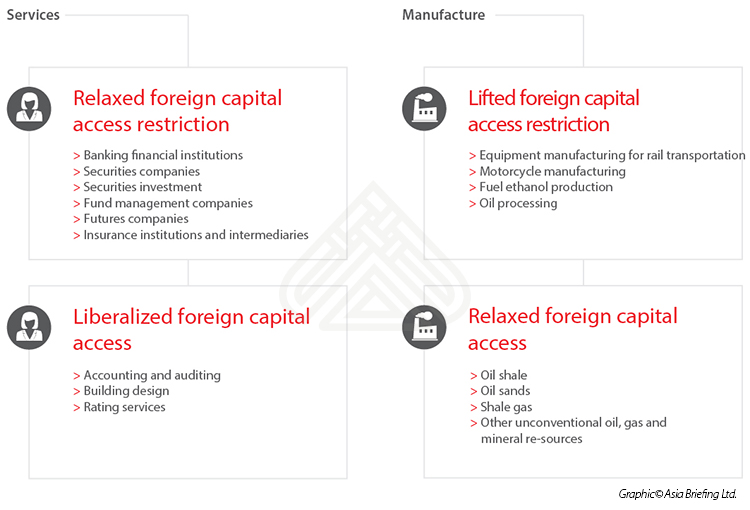By Tongyu Zhang
China’s State Council has issued a circular of the government’s intentions to further open the economy and boost foreign investment. The circular is part of the effort to build China’s so-called “new open economic system,” with measures focused on streamlining government administration, improving regulations, and reducing institutional transaction costs to create a favorable business environment for foreign investment. This is in keeping with the sentiment backed by President Xi Jinping, who has recently released statements defending globalization, signaling the Chinese government’s intent to facilitate the opening-up of the economy.
While this infers a more accessible investment environment, complex global economic and political trends, in addition to China’s ongoing economic restructuring, may mean that foreign investors in China will face a challenging year filled with uncertainties. Furthermore, the circular does not set any concrete policies, but rather offers a general direction for implementation of the measures, which may require some time to be realized.
Further strengthening the opening-up
The measures put considerable emphasis on relaxing restrictions on foreign investment in the service, manufacturing, and mining industries. There are also suggestions to relax restrictions in telecommunications, internet, culture, education, transportation, and other fields. The following table categorizes the different fields and the extent of their relaxed restrictions.
Regarding foreign cooperation in oil and natural gas projects, the regulatory system has changed from an examination and approval system to a record filing system.
The measures also emphasize the role of foreign-invested entities in upgrading the innovation and manufacturing industry in China by encouraging cooperation between domestic and foreign-invested enterprises (FIEs) on research and development activities and easing the resident and business policies for foreign high-level talents.
Fair competition environment
The circular calls for creating a fair and competitive environment. Business licenses and qualification applications of FIEs will be examined with the same standards and processing timetables as those for domestic-invested enterprises. Domestic and foreign-invested enterprises will also get equal access to participate in China’s standardization reform and government procurement in order to enhance the openness and transparency of the country’s investment environment.
The method of expanding FIEs’ financing channel is notable because it allows FIEs to list on the Chinese stock market, including main-board, SME board, GEM board, and new third board, as well as issuing bonds and other debt financing instruments. However, considering the weak performance of the Chinese stock market last year, the effects of such opening-up measures may not be seen in the short term.
Attracting foreign investment
In order to attract foreign investment, local governments will be allowed to form favorable policies to support foreign-invested projects that can facilitate employment, economic development, and technology innovation, and reduce the costs for the investment and operation of FIEs. Support will be provided to the central, western, and northeast regions for undertaking industrial transformation of foreign investment.
Observations
With 20 measures covering various aspects of foreign investment promotion, there have been several different interpretations. In a statement issued after the release of the circular, the National Development and Reform Commission (NDRC) highlighted the tendency of foreign-invested manufacturing enterprises to relocate abroad. To address this, the NDRC emphasized the measures that boost foreign investment in the manufacturing sector, indicating that the Chinese government has prioritized the restructuring and transition of the manufacturing industry. Meanwhile, investors in the market are more concerned about the potential financial sector reform. Bloomberg and Reuters have maintained a cautious attitude when reporting the measures, especially with the country’s recent control of capital outflow, which seems to be at odds with the measures. Thus, it is critical for foreign investors to analyze the policy’s implications based on their own conditions and create an appropriate strategy.
Another notable feature of the circular is that the responsibilities for each measure have been assigned to the relevant government departments, intending to improve their implementation. Therefore, if an entity is interested in a particular measure, it can find more information by contacting the corresponding government department.
About the author: This article first appeared in China Briefing by Dezan Shira & Associates, a specialist foreign direct investment practice, providing corporate establishment, business advisory, tax advisory, and compliance, accounting, payroll, due diligence, and financial review services to multinationals investing in China, Hong Kong, India, Vietnam, Singapore and the rest of ASEAN. For further information, please email [email protected] or visit www.dezshira.com.































